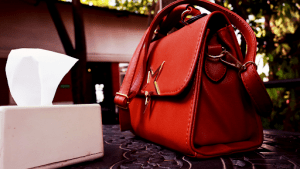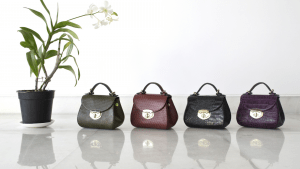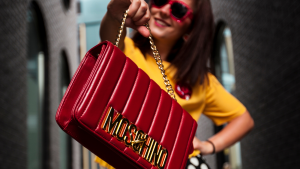BLOGS
How To Take Care Of Your Designer Bags
Designer bags often come with the expectation that they are well made with the highest quality of materials, and sometimes one-of-a-kind, by specially-trained craftsmen. And if you happen to own limited editions, it’s as if you bought artwork or a luxury property by Brittany built by the finest craftsmen in the world. As such, designer bags are often celebrated as heirloom pieces that owners can pass on to one generation and the next. The exclusivity and the high-quality value of designer bags also made them obvious choices for investment.

Having a designer bag is one of the best investments you can have.
But unlike actual art displayed in museums and private collections of the rich and famous, designer bags run the risk of getting dirty, or even stained from use. For some people who use them for what they are, especially during special occasions, designer bags can get dirty or stained from accidental liquid spills, a rogue water spot on a desk, or even raindrops during a surprising downpour. And if you are one of them who happens to use it daily, your well-made designer bag will eventually succumb to wear and tear.
But what if you do not have that many occasions to use your designer bags? Your precious valuables can still be subject to weather changes in the home, especially if it is placed in a spot where it’s too humid or too cold which could cause potential mold to thrive. It is also possible that your designer bags may lose quality due to how you currently store them at home.
Suggested Read: Best Luxury Skincare Brands 2021
We have listed down ways on how to cleverly increase the life of your designer bags, whether you live in a luxury home or luxury condo.
Clean Your Designer Bags Properly

The key is to keep the stain from penetrating the surface of your designer bag.
1. Remove stains right away.
If you happen to get a stain on your designer bag, the first thing you need to do is this: Do not panic! As long as you know the source of the stain and the material of your designer bag, you can remove the stain with little to no visible damage.
For food stains, crush a piece of white-colored chalk and put it directly on the stain. Let it sit for several hours, ideally overnight. Afterward, you can use a clean soft cloth to wipe the chalk away.
If your bag has a water spot, immediately blot them dry. If you got fresh ink on your bag, rub the stain immediately with a white eraser. Avoid rubbing with too much pressure. If you do not have any of these handy, try to remove the stain away using a damp paper tissue or towel.
When cleaning a designer bag made with nylon, you need to hand-wash it gently using mild soap and water, rinse, and press the water out using a large clean towel. Then air-dry instead of using a hairdryer.
For leather bags, dip a soft cloth in warm water and dish soap solution, then wring the excess out before wiping the surfaces. Use a dry soft towel to wipe the leather bags dry. Pay attention to scuffs and water stains.
2. Get rid of funky smells.
Almost all designer bags come with little pouches called desiccants. Aside from the fact that they absorb moisture in the air, they can also reduce the funky smell in your bag.
If you do not have desiccants for your bag, you can shop online or create your own. Simply add baking soda packs or dryer sheets. Herbal sachets are also good, but they are not recommended if the smell you are trying to get rid of is quite powerful.
Leave a desiccant in your bag for several days until there’s no more smell.
3. Don’t forget about the hardware as well.
Some designer bags are retrofitted with hardware from bag clasps, shoulder chain straps, to decorative metals. You may use a microfiber cloth to wipe them clean. For hardware with tiny nooks and crannies, you can use a makeup brush with soft bristles. Avoid using cleaning materials that can cause surface scratches on your bag’s hardware.
4. Use appropriate care products for your designer bags.
For example, designer bags that are made of leather should be cared for with leather cream or balm on a clean white cloth, and then dry off excess while buffing a little using a dry cotton cloth. Designer bags made of suede should be brushed with a suede brush.
There are also products in the market that can protect your designer bags from accidents. For example, special protectant sprays can give protection to most fabrics, including suede and nubuck materials.
Before you do anything though, make sure you consult the care instructions of your designer bag or do a patch test. This way, you avoid the risk of damaging your designer bag further.
Also, be mindful about the maintenance products you are purchasing for your designer bags. Some leather creams, for example, do not work with other types of leather. To be sure, check with the brand’s website for care instructions.
5. Don’t clean your designer bags too much.
Do not risk the urge of cleaning your designer bags often. Sometimes, too much care can cause damage. Only clean your handbag when you need to refresh its look to avoid wearing the surface out more quickly.
You can also use conditioning products like waterproof spray or conditioner spray to keep certain stains away from penetrating the bag’s surface.
6. Make sure that you zip or fasten your designer bags properly.
This is to ensure that any hardware on the overlap handles, for example, does not compromise the shape and wear of the bag. If you leave them hanging on the sides when not in use, the weight of the hardware may add stress or even cause tearing.
7. Use a handbag liner.
A handbag liner, also known as an insert, is an organizer for your bag. A handbag liner not only organizes your bag’s contents and makes it easier to swap bags, but it also allows you to reduce accidents like spillage. For example, ink bleeding from a broken pen may only soak the bottom and sides of the inside of your bag, but not necessarily the bag itself. Some handbag liners come with compartments specifically for holding certain items in place.
8. Seek professional help.
Sometimes, it pays to leave the fixing to the professionals. For tough stains, rips, tears, broken zippers, and pulls, it is better that you send them to a professional cleaning and repair service that you can trust. Some brands allow customers to walk in and bring their designer handbags for repair, which will then be shipped off to an authorized repair service nearby (or sometimes even overseas). You can check out these trusted third-party services in Manila that can repair your precious handbags.
On the other hand, know what professional help can and cannot do for your designer bag. Some designer bags may be beyond repair.
9. Do not wait until the last minute to have your designer bags cleaned or repaired.
Sometimes, small repairs can pile up and affect the entire quality of your handbag. Practice handbag care at the first sign of damage, and then schedule sending your designer bag to a cleaning service or repair shop to get it treated.
10. Embrace imperfections.
While taking care of your handbag is necessary, it’s important to love and carry it, too. You can’t expect your designer handbag to stay put in your closet or storage for the longest time. You need to let your bags breathe and let you love them the way you use and carry them for the first time.
SUGGESTED READ: Iconic Movie Cars: How Much They are Worth | Luxury Living by Brittany
And if it results in some scuffs or some wear and tear, that is okay. Sometimes, these signs of use add more value to your designer handbag, and stories you will love to share with your heirs.
Suggested Reads: Most Expensive Pet Accessories 2021
Now, let’s learn some great storage ideas for your designer handbags.
Storing your designer bags

Your designer handbags deserve the spotlight, even if they are not in use.
11. Protect the shape of your designer bags.
You need to keep the original shape of your handbag when in use, and when not in use.
When using your designer handbag, keep items at a minimum. Avoid filling items till the brim or to a point that the shape of your designer handbag becomes unnatural. Heavy items may also cause your designer handbag to sag from the weight when carried.
When not in use, stuff the inside of your designer bag with a purse base shaper or any kind of dry stuffer like newspaper, a small pillow, packing bubbles, or tissue paper.
12. Cover your designer bags with a dust bag.
Dust bags are a great way to keep dust or mildew away from your designer handbags in storage. Moreover, dust bags will also protect your precious handbags from direct light, which can also cause colors to fade.
13. Leave space in between.
Avoid smashing your precious clutches, totes, and other handbags together, especially if they are made of different materials. Group them in similar make, shape, and size, and then whites to avoid color transfer. If stored together without any space and haphazardly, you may cause unintentional damage like scuffs and scratches on your bags.
14. Put your designer bags on display.
Luxury homes and luxury condos by Brittany often come with walk-in closets with partitions or surfaces that allow you to display your favorites. You can take a cue from your favorite designer boutiques and shops and display your handbags as if they are on sale.
If you do not have space in your closet, have you thought of displaying them in your living space as decor? Show your love for your handbags on top of your bookshelf or your desk, or install hanging shelves dedicated to them. You can also invest in a good clear hanging bag organizer that you can install on an empty wall or the back of your door.If your clothes take up that much space in your closet and drawers, opt for investing in clear storage boxes. You can organize your bags for easy access by labeling the drawers with pictures and brand names. Just be sure not to hang your purses as this could stretch out the handles. Keep your bags at least six to seven inches away from naked or overhead light bulbs.
15. Divvy up your designer bags in clear, labeled storage bins.
Smaller bags like clutches can be stored in upright acrylic shelf dividers or a clear plastic storage container with a lid. You can even add a label on how to take care of them, and what products to use. You can also sort them according to season, so you know which ones you can bust out.
Do the same for designer bags that need repair or are for donation or resale. This way, you’ll know which items require your immediate care.
16. Dedicate a space for your everyday bag.
If you have a designer handbag that you use regularly, install a simple hook in the place where you like to keep your bag when you get home. For most people, this is your entryway. Make sure that you also know how to disinfect your bag properly without using harsh chemicals.
17. Check out these additional storage ideas.
Don’t have extra shelving units in your closet? You can take advantage of cubbies, which are excellent for storing designer handbags in various sizes.
If you have the space to spare in your luxury home or luxury condo, you can also think about installing a peg wall. This way, you have the variation of either hanging some of your designer bags on pegs or setting up mini shelves dedicated to each of your favorites.
Avoid storing smaller bags into larger bags. For large bags that do not have structure, you can fill them in or store them in magazine holders. This way, you can slip three or four of the same kind while keeping the structure and hold of each bag.
Never leave your bags, or even shoes, on the floor.
18. Make sure your closet has proper ventilation.
Stuffy closets in luxury homes are not great places for you to store your valuables. Brittany luxury homes, for example, have living spaces that work best for designer items. But if you have no choice but to keep your designer handbags in a closed-off space, make sure it has lots of ventilation. Open the doors and turn on fans regularly.
Final Thoughts

Your portfolio of bags should not only stand the test of time but are also meant to be enjoyed for the longest.
Just like any other designer goods, designer bags are meant to be enjoyed. Sure, you need to keep them in pristine condition, but what is the point of just keeping them in the closet like ornaments? Designer bags, at their core, are functional accessories. Aside from practicing bag care and maintenance, your designer bags should be able to breathe, shine, and be put on display.
UP NEXT: Why are brands going paraben-free?
















